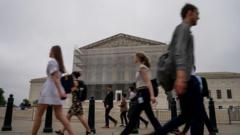The top court's ruling, decided by a 6-3 vote, clarifies the extent of presidential powers and could lead to changes in how future executive actions are legally challenged.
On Friday, the Supreme Court determined that federal judges have limited capability to issue universal injunctions against the executive branch's actions. This ruling was prompted by Trump's executive order to eliminate birthright citizenship for non-citizens and undocumented immigrants, which he signed upon returning to office. The order has faced multiple legal challenges from immigrant rights organizations and several states, which previously succeeded in temporarily blocking it.
The Trump administration argued that these judicial interventions violated the Constitution, and the court concurred, asserting that while courts can still intervene in cases of unconstitutional actions, it will happen later in the judicial process. This gives the executive branch more operational latitude.
President Trump celebrated the decision as a "monumental victory for the constitution," arguing against what he termed the "grave threat to democracy" posed by "radical left judges." He indicated that the ruling would facilitate the immediate implementation of his policies, including the controversial birthright citizenship order.
Legal experts express that this ruling may transform the dynamics of executive authority, signaling that federal courts should refrain from overstepping their powers. Justice Amy Coney Barrett, who wrote the majority opinion, emphasized that federal courts are designed to resolve specific controversies and not to act as general overseers of presidential actions.
Dissenting justices, meanwhile, highlighted concerns about the implications of this ruling on the Constitution, warning that it allows the government to bypass constitutional checks.
As the legal landscape evolves, with potential future challenges to the ruling anticipated, the Supreme Court has effectively reshaped the dialogue around executive power and judicial oversight in the United States.
On Friday, the Supreme Court determined that federal judges have limited capability to issue universal injunctions against the executive branch's actions. This ruling was prompted by Trump's executive order to eliminate birthright citizenship for non-citizens and undocumented immigrants, which he signed upon returning to office. The order has faced multiple legal challenges from immigrant rights organizations and several states, which previously succeeded in temporarily blocking it.
The Trump administration argued that these judicial interventions violated the Constitution, and the court concurred, asserting that while courts can still intervene in cases of unconstitutional actions, it will happen later in the judicial process. This gives the executive branch more operational latitude.
President Trump celebrated the decision as a "monumental victory for the constitution," arguing against what he termed the "grave threat to democracy" posed by "radical left judges." He indicated that the ruling would facilitate the immediate implementation of his policies, including the controversial birthright citizenship order.
Legal experts express that this ruling may transform the dynamics of executive authority, signaling that federal courts should refrain from overstepping their powers. Justice Amy Coney Barrett, who wrote the majority opinion, emphasized that federal courts are designed to resolve specific controversies and not to act as general overseers of presidential actions.
Dissenting justices, meanwhile, highlighted concerns about the implications of this ruling on the Constitution, warning that it allows the government to bypass constitutional checks.
As the legal landscape evolves, with potential future challenges to the ruling anticipated, the Supreme Court has effectively reshaped the dialogue around executive power and judicial oversight in the United States.






















